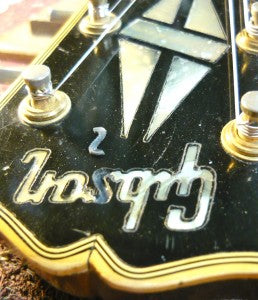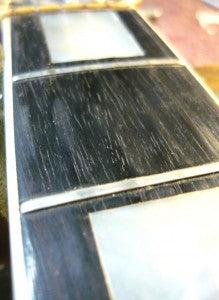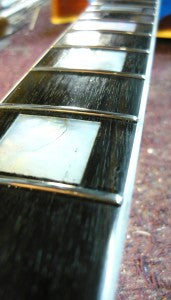1973 Gibson Les Paul Custom
Share
This is such a nice Les Paul. I'm a big fan of these early/mid seventies Les Pauls with too much maple, sandwiched body and all the wrong angles and those big lumps on the back of those three piece necks ..............
This ones been played and played some more. The owner has had it since new and it's been his main guitar for all that time. It was in for a re-fret and some electronics work which is pretty good considering it's age and use.
After 40 years it was time to give a little back and it had become almost unplayable with the frets that were in it. As I've said before I don't recommend re-frets lightly, but this NEEDED one, badly if it was going to be used as it was used to.
The frets on these can be tricky to get out without damaging the fretbaord. The ebony Gibson has used over the years varies dramatically and during the seventies and eighties it can be VERY brittle. It's not too much trouble except in the slots closest to the block inlays. The slots get VERY close to the inlays and pieces can chip out of these areas easily even when taking great care. Not all Gibsons are like this and this one was pretty good considering it's age.
I heated up each fret and carefully removed them trying to rock the fret just slightly and then pull straight up. They all came out well and left very little damage to the fretboard.
With the body masked off it was time to flatten out the fretboard. I don't like to remove the binding on these if I can help it and this neck had been so played that the nub ends were very worn so they weren't sticking out and easily knocked off while sanding.
I carefully sanded the fretboard making sure to clear the nub ends and get the board back to a flat surface. This Les Paul, like a lot of them, had a hump at the area where the neck joins the body and this needed to be flattened out if this re-fret was going to be worthwhile.
I didn't want to take too much off the fretboard as these inlays can be thin sometimes and the slots aren't too deep. Even with the board flat I still had wear marks in the board, which shows how much this has been played. Finger grooves in an ebony board is rare.
Doing a re-fret this way you need to cut each fret exactly to size before installing them. You can't trim anything after so time taken here pays off later. The tang has to be perfect to fit in the length of the slot and the fret crown has to fit between the nubs.
Each fret is cut to size and put in it's numbered hole so I can come back and fit them all at once.
With them all cut to size it's just a matter of installing them carefully. I did this the "old fashioned" way by hammering them in. I prefer this method, especially on set neck guitars so there's even pressure (and method) over the entire fretboard, rather than pressing in up to the 14th or so fret and then hammering in the rest.
With the frets in and dressed it was time for as new nut as the old (original) nut was way too low for the new higher frets. A bone blank is cut to size and the old slot cleaned up ready for installation.
I marked the string spacing off the old nut as with guitars played like this by one person forever, I usually mark straight off the original as the owner is so used to this spacing that weather it's actually right or not is irrelevant. They are comfortable and familiar with this spacing and as such it works best for them.
With the new nut in it was obvious the bridge was going to need looking at. It's common on Gibsons with tune-o-matic and stop tailpiece where the tailpiece has been screwed down hard to the body for the bridge to be bowed in the middle due to the tension of the strings pulling down too hard. Since the bridge is mostly hollow and supported at each end, it collapses in the middle, making the radius on the saddles out to the radius of the fretboard. What this means is the action in the middle are lower than the action on the outside.
The saddles can sometimes be slotted deeper on the outside saddles to get your radius back as long as the slots don't get too deep and the strings hit the bridge body. This bridge was too far gone, and in reality had done its job for fourty years.
The electrics also needed looking at as all the pots crackled and the neck pickup volume pot cut out when on full. All the electrics are original and the pots date 31st week, 1973. In cases like this I will clean the pots first to try and salvage any original parts I can. While I usually won't keep original parts at the expense of functionality unless a customer asks me to, these parts came up in almost full working order and certainly enough to keep the guitar working.


While editing the pics for this story I noticed that the "S" in the Gibson headstock logo had gone. This happens because the inlay material shrinks over time and the inlay cracks and bits fall out.
After much searching (if you saw my workshop you'd know why) I found the S and glued it back in place. I could have cut a new bit and glued it in, but that wouldn't be right, would it ?






































